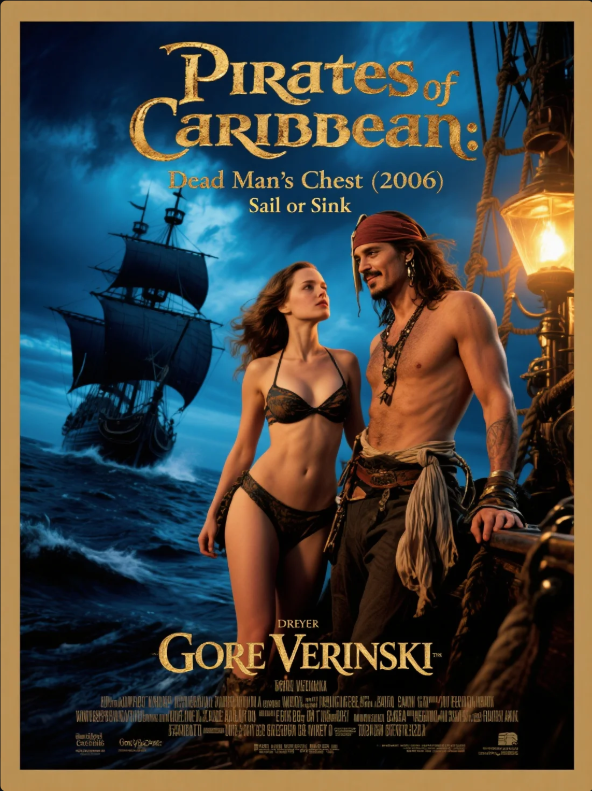Pirates of the Caribbean: Dead Man’s Chest (2006) Movie Review: A Thrilling Sequel That Raises the Stakes

Pirates of the Caribbean: Dead Man’s Chest (2006), directed by Gore Verbinski, is the ambitious follow-up to the 2003 blockbuster The Curse of the Black Pearl. With Johnny Depp reprising his iconic role as Captain Jack Sparrow, alongside Orlando Bloom, Keira Knightley, and a stellar supporting cast, this sequel expands the swashbuckling universe with darker themes, jaw-dropping visuals, and high-stakes adventure. In this 2000-word review, optimized for SEO, we’ll explore the film’s plot, performances, direction, cinematography, music, and cultural impact, analyzing why Dead Man’s Chest remains a bold and thrilling chapter in the Pirates of the Caribbean franchise.
Overview of Dead Man’s Chest
Released on July 7, 2006, Dead Man’s Chest was a highly anticipated sequel following the runaway success of its predecessor. Produced by Jerry Bruckheimer and distributed by Walt Disney Pictures, the film builds on the world established in The Curse of the Black Pearl, introducing new characters, mythical creatures, and a more complex narrative. With a budget of $225 million, it was one of the most expensive films of its time, but it paid off, grossing over $1.06 billion worldwide, making it the highest-grossing film of 2006.

The story picks up with Jack Sparrow, Will Turner, and Elizabeth Swann facing new challenges as they navigate a web of betrayals, debts, and supernatural forces. The introduction of Davy Jones, played by Bill Nighy, and his monstrous Kraken elevates the stakes, delivering a darker, more epic adventure that sets the stage for the trilogy’s conclusion in At World’s End (2007).

Plot Summary: A Tale of Debts and Destiny
Dead Man’s Chest begins with Will Turner (Orlando Bloom) and Elizabeth Swann (Keira Knightley) facing arrest on their wedding day for aiding Jack Sparrow’s escape in the first film. Lord Cutler Beckett (Tom Hollander), a ruthless East India Trading Company official, offers them a pardon in exchange for Jack’s magical compass, which points to the user’s deepest desire.

Meanwhile, Jack Sparrow is on the run from a debt he owes to Davy Jones (Bill Nighy), the ghostly captain of the Flying Dutchman. Jack must find the heart of Davy Jones, hidden in the titular Dead Man’s Chest, to avoid serving a century aboard Jones’ cursed ship. As Will and Elizabeth become entangled in Jack’s quest, they encounter mythical creatures, including the Kraken, and face moral dilemmas that test their loyalties.
The plot weaves multiple storylines—Jack’s evasion of Davy Jones, Will’s mission to save his father, “Bootstrap” Bill Turner (Stellan Skarsgård), and Elizabeth’s growing independence—culminating in a shocking cliffhanger that leaves audiences eager for the next installment.

Why the Plot Works
The narrative’s strength lies in its ability to expand the Pirates universe while maintaining the humor, action, and romance that made the first film a hit. The introduction of Davy Jones and the Kraken adds a mythological depth, while the cliffhanger ending, though divisive, creates anticipation for the trilogy’s resolution. However, the film’s sprawling subplots can feel convoluted at times, a minor flaw in an otherwise engaging story.
Exceptional Performances: A Cast at Its Peak
The film’s ensemble cast delivers performances that elevate the sequel’s ambitious scope.
Johnny Depp as Captain Jack Sparrow
Johnny Depp returns as Jack Sparrow, bringing the same roguish charm that earned him an Oscar nomination in the first film. In Dead Man’s Chest, Jack is more morally ambiguous, grappling with his selfish instincts and fear of Davy Jones. Depp’s comedic timing, particularly in scenes like the cannibal island escape, is impeccable, and his ability to balance humor with vulnerability keeps Jack captivating.
Orlando Bloom as Will Turner
Orlando Bloom’s Will Turner evolves from the earnest hero of the first film into a more conflicted figure. His quest to save his father adds emotional weight, and Bloom portrays Will’s growing frustration and determination with nuance. His chemistry with Knightley remains a highlight, grounding the film’s fantastical elements.
Keira Knightley as Elizabeth Swann
Keira Knightley shines as Elizabeth, who emerges as a fiercer, more independent character. Her journey from damsel to cunning adventurer is compelling, and Knightley’s commanding presence holds her own against Depp’s larger-than-life performance. Elizabeth’s pivotal decisions in the film’s climax showcase her complexity.
Bill Nighy as Davy Jones
Bill Nighy’s portrayal of Davy Jones, brought to life through motion-capture technology, is a standout. With his octopus-like face and Scottish accent, Nighy creates a villain who is both terrifying and tragic. Jones’ backstory, involving a lost love, adds depth, making him one of the franchise’s most memorable antagonists.
The supporting cast, including Stellan Skarsgård as Bootstrap Bill, Naomie Harris as the mystic Tia Dalma, and Jack Davenport as Norrington, enriches the story. Tom Hollander’s Cutler Beckett introduces a new kind of villainy, representing corporate greed and colonial ambition.
Direction and Cinematography: Gore Verbinski’s Epic Vision
Gore Verbinski’s direction in Dead Man’s Chest is bolder and more ambitious than in the first film. He embraces a darker tone, blending horror-inspired elements with the series’ signature humor. The cannibal island sequence, the Kraken attacks, and the climactic wheel fight showcase Verbinski’s ability to stage inventive, large-scale action scenes.
Cinematographer Dariusz Wolski returns, capturing the film’s diverse settings—from the murky swamps of Tia Dalma’s lair to the stormy seas of the Flying Dutchman—with stunning clarity. The visual palette is moodier than the first film, with muted greens and blues that reflect the story’s darker themes. The Kraken sequences, with their chaotic underwater shots, are particularly breathtaking.
Visual Effects and CGI
The film’s visual effects, overseen by Industrial Light & Magic, are groundbreaking. Davy Jones and his crew, with their sea-creature-inspired designs, are a triumph of motion-capture and CGI, earning the film an Academy Award for Best Visual Effects. The Kraken, a massive sea monster, is rendered with terrifying realism, its attacks among the most memorable set pieces in the franchise. The seamless integration of practical effects, such as ship models, with digital elements creates a fully immersive world.
Music and Soundtrack: Hans Zimmer’s Legendary Score
Hans Zimmer takes over as the primary composer for Dead Man’s Chest, building on Klaus Badelt’s themes from the first film. Zimmer’s score is richer and more emotional, with haunting motifs for Davy Jones and thunderous percussion for the action scenes. The organ-driven “Davy Jones” theme is particularly iconic, evoking both menace and melancholy.
The soundtrack enhances the film’s emotional beats, from the tender moments between Will and Elizabeth to the pulse-pounding Kraken attacks. The sound design, with the creak of the Flying Dutchman and the roar of the Kraken, immerses viewers in the high-seas adventure. The film earned Oscar nominations for Best Sound Editing and Best Sound Mixing.
Themes and Symbolism
Dead Man’s Chest explores themes of sacrifice, betrayal, and the cost of freedom. Jack’s debt to Davy Jones symbolizes the consequences of his reckless lifestyle, while Will’s quest to save his father reflects the burden of familial duty. Elizabeth’s arc challenges gender norms, as she navigates a male-dominated world with cunning and courage.
The film also critiques colonialism through Cutler Beckett’s East India Trading Company, which seeks to control the seas for profit. Davy Jones’ tragic backstory adds a layer of romantic melancholy, making him a complex foil to Jack’s carefree persona.
Cultural Impact and Legacy
Dead Man’s Chest solidified Pirates of the Caribbean as a cultural phenomenon. Its billion-dollar box office cemented the franchise’s dominance, leading to three more sequels: At World’s End (2007), On Stranger Tides (2011), and Dead Men Tell No Tales (2017). The film’s success also reinforced Johnny Depp’s status as a box office draw and boosted the careers of Bloom, Knightley, and Nighy.
The introduction of Davy Jones and the Kraken expanded the franchise’s mythology, inspiring merchandise, video games, and theme park updates. The film’s visual effects set a new standard for CGI, influencing subsequent blockbusters. Lines like “I’ve got a jar of dirt!” became pop culture staples, and the cliffhanger ending sparked endless fan debates.
However, the film’s complex plot and unresolved ending polarized some viewers, with critics arguing it prioritized spectacle over coherence. Despite this, its ambition and entertainment value have ensured its enduring popularity.
Strengths and Weaknesses
Strengths
-
Memorable Characters: Jack, Will, Elizabeth, and Davy Jones are richly developed, with compelling arcs.
-
Stunning Visuals: The CGI, cinematography, and set design create a breathtaking world.
-
Epic Action: The Kraken attacks and wheel fight are thrilling and inventive.
-
Emotional Depth: The themes of sacrifice and betrayal add weight to the adventure.
Weaknesses
-
Complex Plot: The multiple storylines can feel overwhelming and unresolved.
-
Pacing Issues: At 151 minutes, some scenes, like the cannibal island, drag slightly.
These flaws are minor in the context of the film’s overall impact and entertainment value.
Why Dead Man’s Chest Endures
Dead Man’s Chest succeeds as a sequel by taking risks. It expands the Pirates universe, introduces unforgettable characters, and delivers spectacle on an unprecedented scale. While it lacks the standalone perfection of The Curse of the Black Pearl, its ambition and emotional resonance make it a worthy successor.
The film’s rewatchability lies in its iconic moments—Jack’s escapes, the Kraken’s wrath, and the heart-pounding climax. It’s a testament to the franchise’s ability to evolve while retaining the humor, heart, and adventure that fans love.
Conclusion: A Swashbuckling Triumph
Pirates of the Caribbean: Dead Man’s Chest is a thrilling, visually spectacular sequel that pushes the boundaries of the pirate genre. Johnny Depp’s magnetic performance, Gore Verbinski’s visionary direction, and a stellar cast make it a standout blockbuster. From its groundbreaking effects to Hans Zimmer’s soaring score, every element is crafted with care, delivering an adventure that’s both epic and intimate.
Whether you’re drawn to the action, the mythology, or the characters, Dead Man’s Chest is a cinematic journey worth taking. As Jack Sparrow might say, “Bring me that horizon!”—and this film delivers it in spades.
SEO Keywords
-
Pirates of the Caribbean
-
Dead Man’s Chest
-
Johnny Depp
-
Jack Sparrow
-
Davy Jones
-
Gore Verbinski
-
Orlando Bloom
-
Keira Knightley
-
Movie review
-
2006 films
-
Adventure movies
-
Disney films
-
Kraken
-
Bill Nighy
This review is designed to rank highly on search engines while offering an in-depth, engaging analysis for readers. For more movie reviews and cinematic insights, explore our site!











